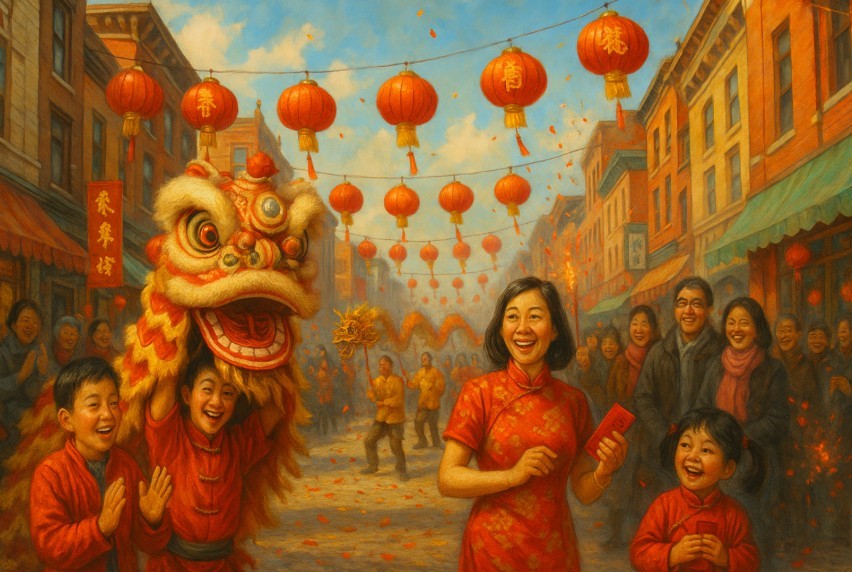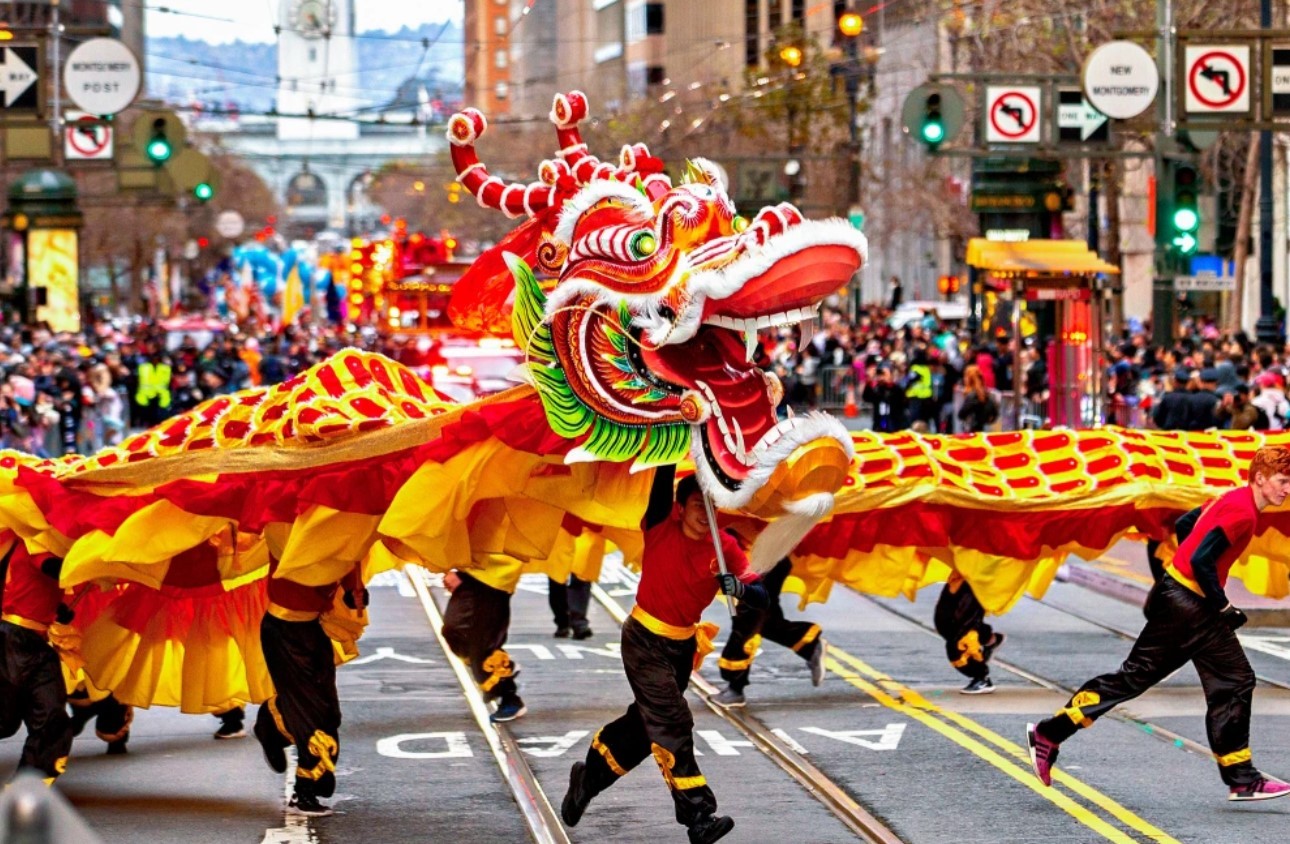How to Make Nian Gao (Sticky Rice Cake) with New Ways, Easy Steps
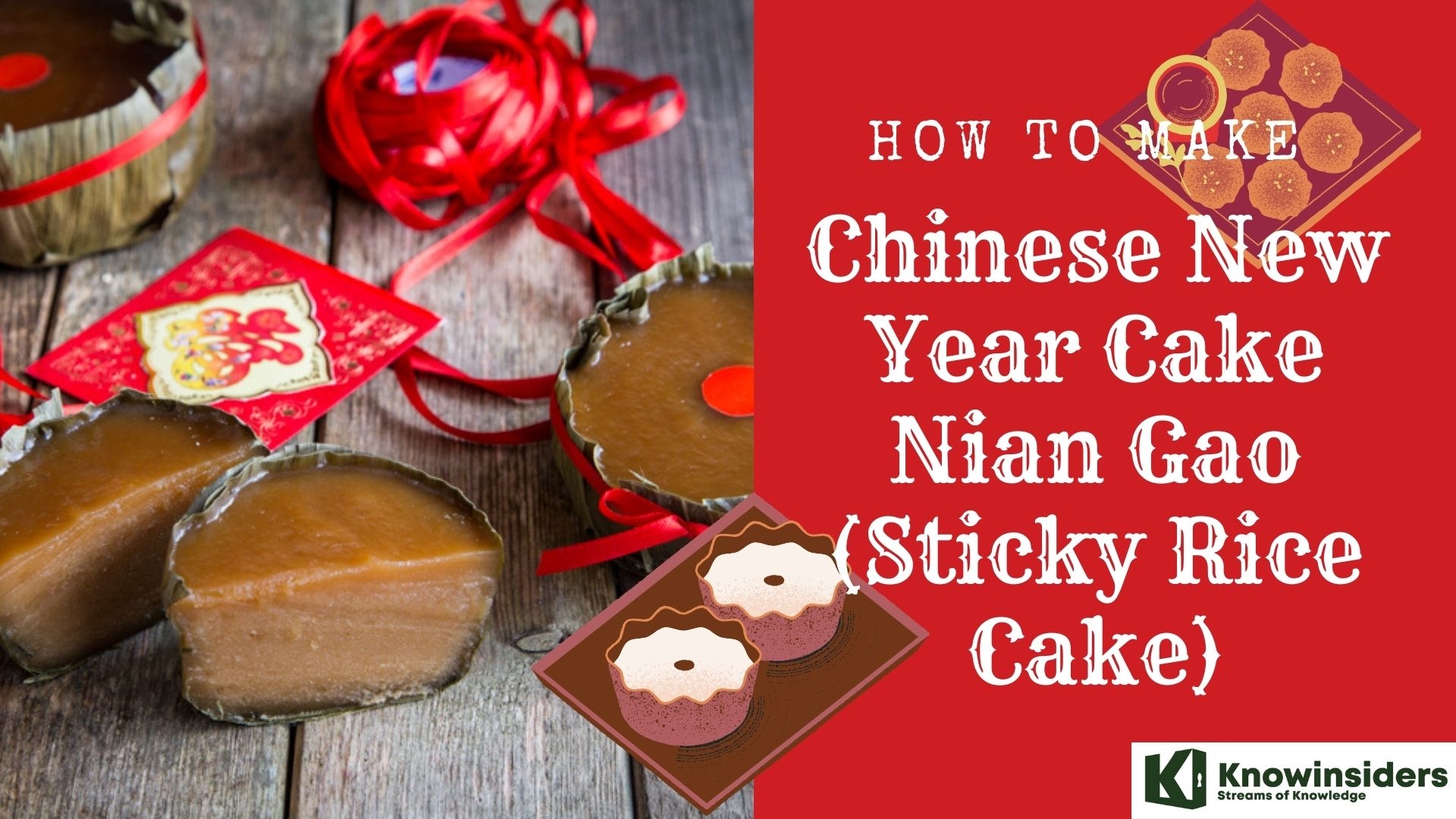 |
| How to Make Chinese New Year Cake Nian Gao (Sticky Rice Cake): What Is, Tips, Step – By- Step Guide |
| Table of Contents |
Chinese New Year, Spring Festival or the Lunar New Year, is the festival that celebrates the beginning of a new year on the traditional lunisolar Chinese calendar. In Chinese culture and East Asian countries, the festival is commonly referred to as Spring Festival as the spring season in the lunisolar calendar traditionally starts with lichun, the first of the twenty-four solar terms which the festival celebrates around the time of the Lunar New Year.
Nian gao, sometimes translated as year cake or New Year cake or Chinese New Year's cake, is a food prepared from glutinous rice flour and consumed in Chinese cuisine. It is also simply known as "rice cake". While it can be eaten all year round, traditionally it is most popular during the Chinese New Year. It is considered good luck to eat nian gao during this time of the year because nian gao (年糕) is a homonym for "higher year" or "grow every year" (年高), which means "a more prosperous year".
In the article below, we can learn more on what Nian Gao is, tips to make it by following an easy step by step guide.
What Is Nian Gao - Chinese New Year Cake?
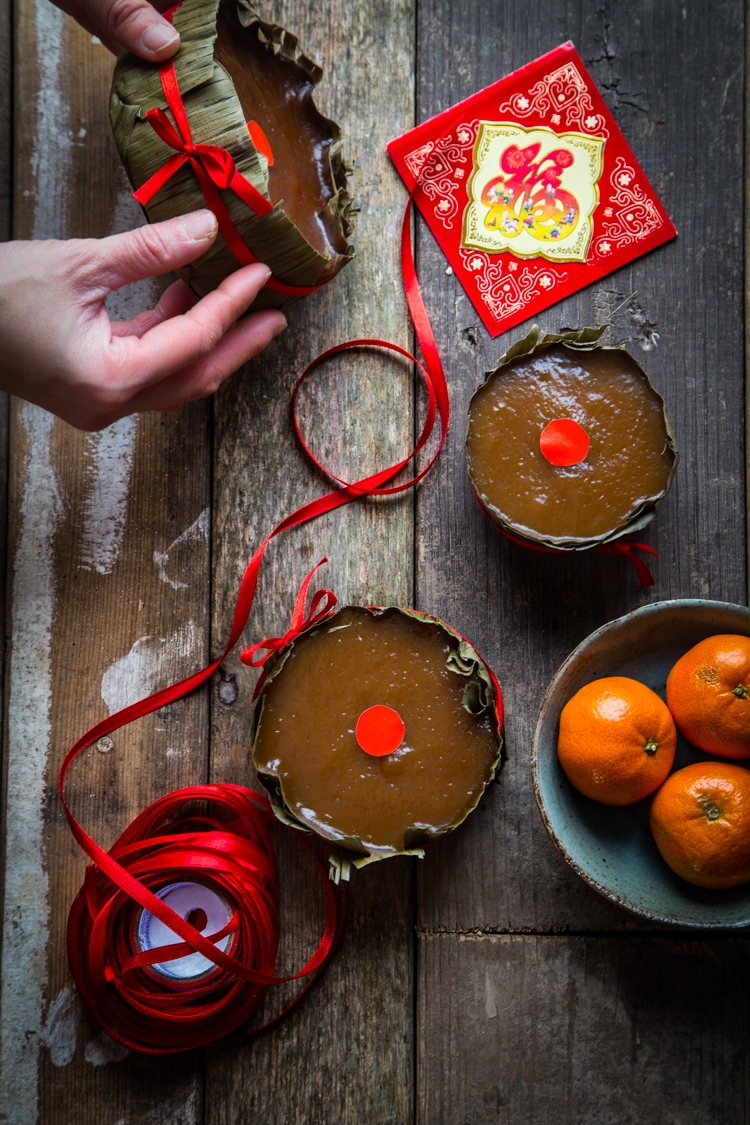 |
| Photo: What To Cook Today |
Nian gao is a traditional food eaten during Chinese New Year. People believed it carries auspicious meaning.
Nian gao is a homonym for "higher year." The Chinese word 粘 (nián), meaning "sticky", is identical in sound to 年, meaning "year". The word 糕 (gāo), meaning "cake" is identical in sound to 高, meaning "high or tall".
For old people, nian gao expresses the wish for longevity. For young people, it expresses the wish for promotion and high income. For kids, it expresses the wish to grow up.
The main color of nian gao is yellow and white. In Chinese culture, yellow symbolizes gold and white symbolizes silver. So nian gao also symbolizes the God of Wealth.
Whether from the point of view of pronunciation or color, nian gao is a lucky food and it sends good wishes for a better year.
History of Nian Gao
The history of nian gao is over 2000 years. After the Chinese Calendar established in the Zhou Dynasty (11th century BC - 256 BC), Chinese people began to have the concept of "year". From then on, people offered nian gao as sacrifices to gods and ancestors.
In the Tang Dynasty (618 – 907 AD), nian gao became a traditional Chinese food eaten during the Spring Festival.
In the Qing Dynasty (1636 – 1912), nian gao developed into a common folk snack eaten all year round, but it is still a special treat for the festival.
 |
| Photo: We Desserts |
The Kitchen God Legend
The sticky sweet rice cake niangao was believed to have been created as a cunning offering to the Kitchen God, who is believed to reside in every house. At the end of every year, folklore says, the Kitchen God makes his “yearly report” to the Jade Emperor. To prevent him from badmouthing their house, people offered niangao, which would stick his mouth shut. Hence, niangao is prepared for offering before Chinese New Year.
The Foundation Bricks Legend
Nian Gao has another legend about its origin, dating back to around 2,500 years ago:
Legend has it that, after the death of Wu Zixu (伍子胥, 559–484 BC), a general and politician of the Wu kingdom in the Spring and Autumn Period (771–476 BC), the king of Yue, Goujian, attacked the capital of Wu, and the Wu army and citizens were trapped in the city and there was no food. Many people starved to death during the siege.
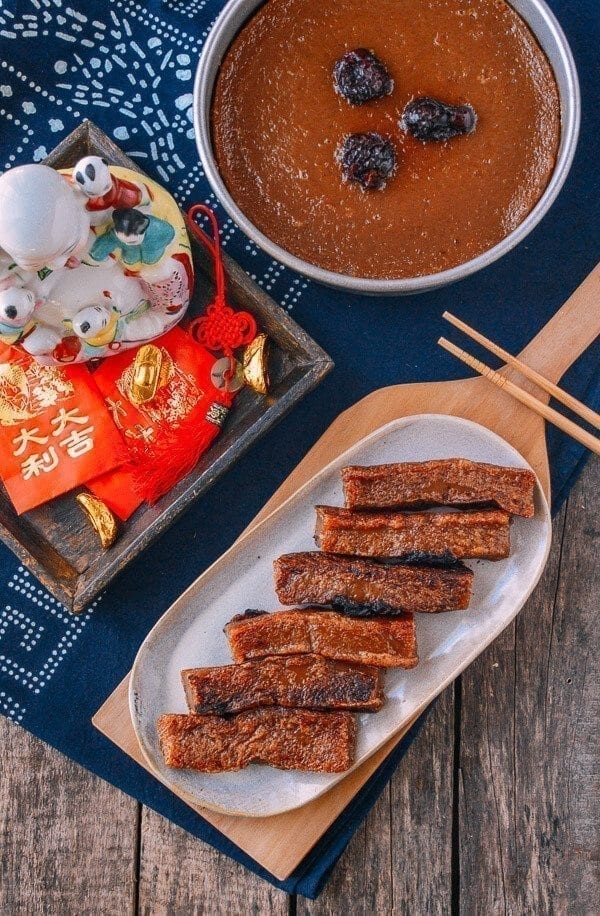 |
| Photo: The Woks of Life |
At this time, someone thought of Wu Zixu's helpful words: "If the country is in trouble and the people are in need of food, go and dig three feet under the city wall and get food." The soldiers did what Wu Zixu instructed and found that the wall’s foundation was built with special bricks made from glutinous rice flour. This food saved many people from starvation. These bricks were the supposed original niangao.
After that, people made niangao every year to commemorate Wu Zixu. As time passed, niangao became what is now known as Chinese New Year cake.
Different types of Nian Gao
Guangdong/Cantonese cuisine
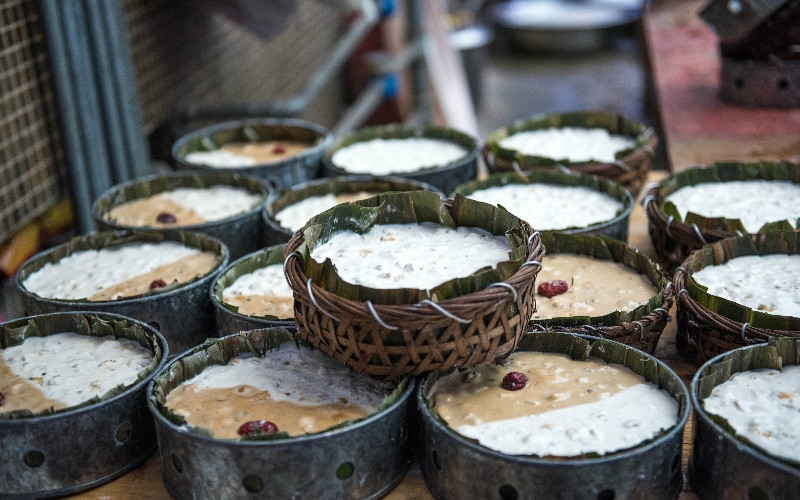 |
| Photo: China Highlights |
The Guangdong type is typically sweetened with brown sugar. It is recognizable due to its dark yellow hue. To settle the mixture, the paste is poured into a cake pan and steam-cooked again. Thick slices of the batter are served after it has solidified through steaming. It can be consumed raw. The nian gao gets very sticky and pliable. It can also be served as a pudding with red bean paste or rosewater flavoring.
The following step is optional since it can be sliced and pan-fried later, frequently with an egg, to make fried nian gao (Jyutping: zin1 nin4 gou1, Pinyin: jiān nián gāo, Chinese: 煎年糕). When fried, the inside stays pasty while the outside gets slightly crispy. It is cut into square pieces and served with other cake dim sum dishes, such as taro cakes and water chestnut cakes, during the Chinese New Year. In addition, people send bits of nian gao to friends and family as well as wishes for wealth and good fortune.
Fujian/Hokkien cuisine
Natural amber known as "nian gao" is primarily used for gifts and New Year's rituals in the southern region of Fujian. It is made with taro and glutinous rice, which are typically sliced and cooked before consumption. To fry, it can also be wrapped in an egg, sweet potato, or cornstarch (corn flour).
Jiangnan and Shanghainese cuisine
 |
| Photo: Miki's Food Archives |
Nian gao is a mild food that grows in the Jiangnan region along the lower reaches of the Yangtze River. It is white in color. It is prepared by combining rice and glutinous rice, with the ratio between the two being customizable to suit individual tastes.
Glutinous rice makes up a larger portion of the softer version. Steaming, frying, slicing, and soup-making are some of the cooking techniques. The most well-known is Ningbo nian gao; other popular dishes include shepherd's purse fried nian gao and pickled pork soup nian gao. Shanghai's nian gao (ribs) are particularly unique. Shanghai Niangao style is typically sold in thick, supple rods that are meant to be sliced or packaged already sliced for use in stir-frying or soups.
There are soft and chewy variations of this style depending on how it is cooked. The Shanghai method uses nonglutinous rice and maintains the nian gao white. Its unique quality is its color. The name (炒年糕, chŎo nián gāo) comes from the stir-frying technique, which is the most commonly used when serving a dish. There are three broad categories. The first is a savory dish that is typically made with cabbage, Chinese cabbage, beef, pork, and scallions.
The second is sweet and made with regular white sugar. The final version is almost entirely flavorless and is primarily eaten for its chewy textures.
Northern cuisine
Northern nian gao has a mostly sweet flavor and can be steamed or fried. Beijing's renditions feature minced nian gao, white nian gao, and jujube jujube combined with either glutinous rice or yellow rice. Nan gao is made by the Shanxi using fried yellow rice and either jujube paste or red bean paste for the filling. Hebei makes steamed nian gao with green beans, small red beans, and jujube. It is made in Shandong with yellow rice and red dates. Beans on sticky sorghum make up the Northeastern variety.
What Does Rice Symbolize Chinese New Year?
For good reason, these sweet rice balls are popular during the Chinese New Year: their circular form represents unity. Because the Chinese word for "reunion" (tuan yuan) sounds similar to the name of these luscious balls (tang yuan), they also symbolize harmony and family unity.
Rice (汳饭; mĐfàn) is a symbol of fertility, wealth, and a connection between the gods and the earth (men). Nian gao, also known as sticky rice cake or pinyin: nián'gāo, is a traditional Chinese new year's dessert. Eating nian gao is said to bring good fortune because it symbolizes growing wealth annually.
Nian gao, also known as "year cake," is a sticky rice cake that symbolizes prosperity. The word "nian gao" means "getting higher year on year," signifying that one should grow taller with each passing year.
Why do people eat rice on Chinese New Year?
Rice (汳饭; mĐfàn) is a symbol of fertility, wealth, and a connection between the gods and the earth (men). Nian gao, also known as sticky rice cake or pinyin: nián'gāo, is a traditional Chinese new year's dessert. Eating nian gao is said to bring good fortune because it symbolizes growing wealth annually.
When it comes to prosperity, luck, fertility, fresh starts, sharing, camaraderie, and success, rice is a lucky charm in dreams. A dream containing rice is auspicious, portending happiness and joy.
How To Make Nian Gao: Easy And Simple Step-By-Step Guide
 |
| Photo: What To Cook Today |
Step 1: Wrap the mold with banana leaves
-Make sections out of the banana leaves.
-Wash the leaves with running water. Allow to air dry.
-To soften the banana leaves, soak them in hot water. Alternatively, heat the banana leaves over a stove to soften them. When heat-treated banana leaves are wrapped around the mold, they become softer and less likely to break. Because it is quicker and easier, I prefer to heat the banana leaves over the stove.
-Wrap the banana leaves around the mold's rim and insert the remaining banana leaves into the mold.
-Place a smaller round container into the mold and press the leaves against the mold's base and inner wall.
-Repeat the process with one or two more leaves.
-Next, cut a round-shaped leaf with a diameter slightly larger than the base. Insert and press against the bottom to completely cover the base.
-Secure the leaf's position by wrapping a rubber band around the container's rim.
Tips-Obtain a suitable mold for the nian gao. The ideal size is 8 to 10 cm (3 to 4 inches) in diameter. -You can certainly buy this type of mold in a store. However, if it is unavailable or you do not want to buy it just to make the nian gao once a year, you can use any empty metal cans. You're ready to go once you've cleaned the can. Most traditional nian gao producers in my hometown use this method. In addition, ramekins can be used as molds. -It is critical to completely cover the inner surface to prevent the glutinous rice flour mixture from leaking out during steaming. Because glutinous rice flour is very sticky, removing the nian gao from the container can be difficult if it sticks to the can. -The use of multi-layers of leaves not only prevents the rice flour mixture from leaking, but also infuses the nian gao with the aroma and flavor of banana leaves. -If you don't have banana leaves, line the mold with nonstick baking paper instead. However, the natural aroma of the banana leaves will be missing from nian gao. |
Step 2: Caramelized the sugar for better flavor
-In a small saucepan, heat the granulated sugar over low heat.
-Continue to stir until most of the sugar has melted and turned golden brown.
-Incorporate the hot water or pandan extract gradually into the caramelized sugar. Be careful not to add too much sugar at first because it will react with the water and quickly boil.
-Once you've finished adding the water, stir it in and set it aside. Any remaining sugar will dissolve on its own as it cools.
Step 3: Constitute the glutinous rice flour mixture
-Measure the required amount of glutinous rice flour in a large container.
-Add the caramelized sugar syrup into the glutinous rice flour slowly.
-Combine the syrup and the rice flour into a smooth batter with a fork or a handheld mixer.
-Let it passes through a wire mesh strainer to remove any possible lumps.
Step 4: Steam the nian gao
-Pour the mixture into the mold line with the banana leaves.
-Cover the molds with aluminum foil.
-Set up a steaming station. Steam the nian gao over medium heat with the lid on for 30 minutes.
-Reduce the heat slightly and continue steaming over medium heat for another 1 1/2 hours.
-After 2 hours of steaming, remove the nian gao and let it cool at room temperature.
-To unmold the nian gao, fold the leaves upwards, then pull the nian gao out from the mold.
-Cut off the excess leaves on top of nian gao, and there you go, your nian gao is ready.
TipsSince steaming the nian gao takes two hours, periodically check the water level in the pot to make sure there is always enough water for steaming. When the color reaches room temperature again, it will become slightly darker. |
To serve
One can serve Nian Gao by himself. It's actually better to slice it, brush it with egg, and deep fry it until golden brown.
Ginja made just now is incredibly soft. After two days in the refrigerator, it becomes firmer, making it easier to cut into slices.
The traditional method of making nian gao involves steaming the food for roughly 20 hours, or until all of the water is gone. It does not need to be refrigerated and can therefore be stored for an extended period of time. The modern method takes far less time, but it still needs to be refrigerated because it molds easily at room temperature.
Tips to make a delicious Nian Gao1. Chinese people typically cover the nian gao with red paper. It's not surprising; this is a customary way of wishing someone well. 2. Because nian gao is made with glutinous rice flour, which is difficult to digest, avoid eating too much at once. 3. Keep nian gao somewhere cool and dry. It keeps well in the refrigerator for up to six months. When you're ready to eat, just reheat it in a microwave or steamer. |
 How to Buy and Sell Cryptocurrencies In Philippines? How to Buy and Sell Cryptocurrencies In Philippines? Cryptocurrency is so popular in Philippines. How to invest, buy and sell cryptos, most popular cryptos, laws? |
 How to Celebrate a Vietnamese New Year's (Tet) How to Celebrate a Vietnamese New Year's (Tet) The lunar new year holiday, known simply as Tết, is the happiest time of year in Vietnam. How to celebrate Vietnamese New Year (Tet)! |
 How to Make Hoppin' John with Simple Steps How to Make Hoppin' John with Simple Steps Some Americans eat certain foods either at New Year's Eve parties with Hoppin' John, a southern dish made of black-eyed peas. |
 How to Choose Best Outfits for Women to Celebrate New Year How to Choose Best Outfits for Women to Celebrate New Year This animal loves creative and courageous people who aren’t afraid to experiment with clothes. Follow this article to explore some tips to choose your New ... |

